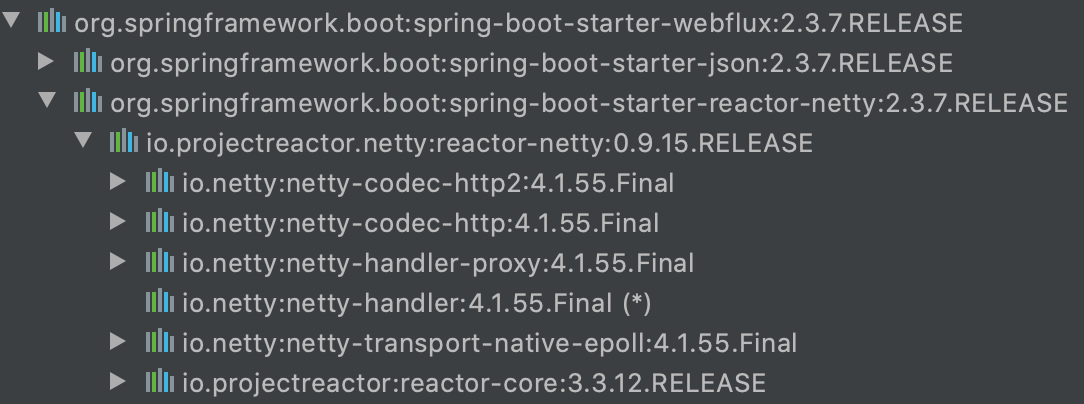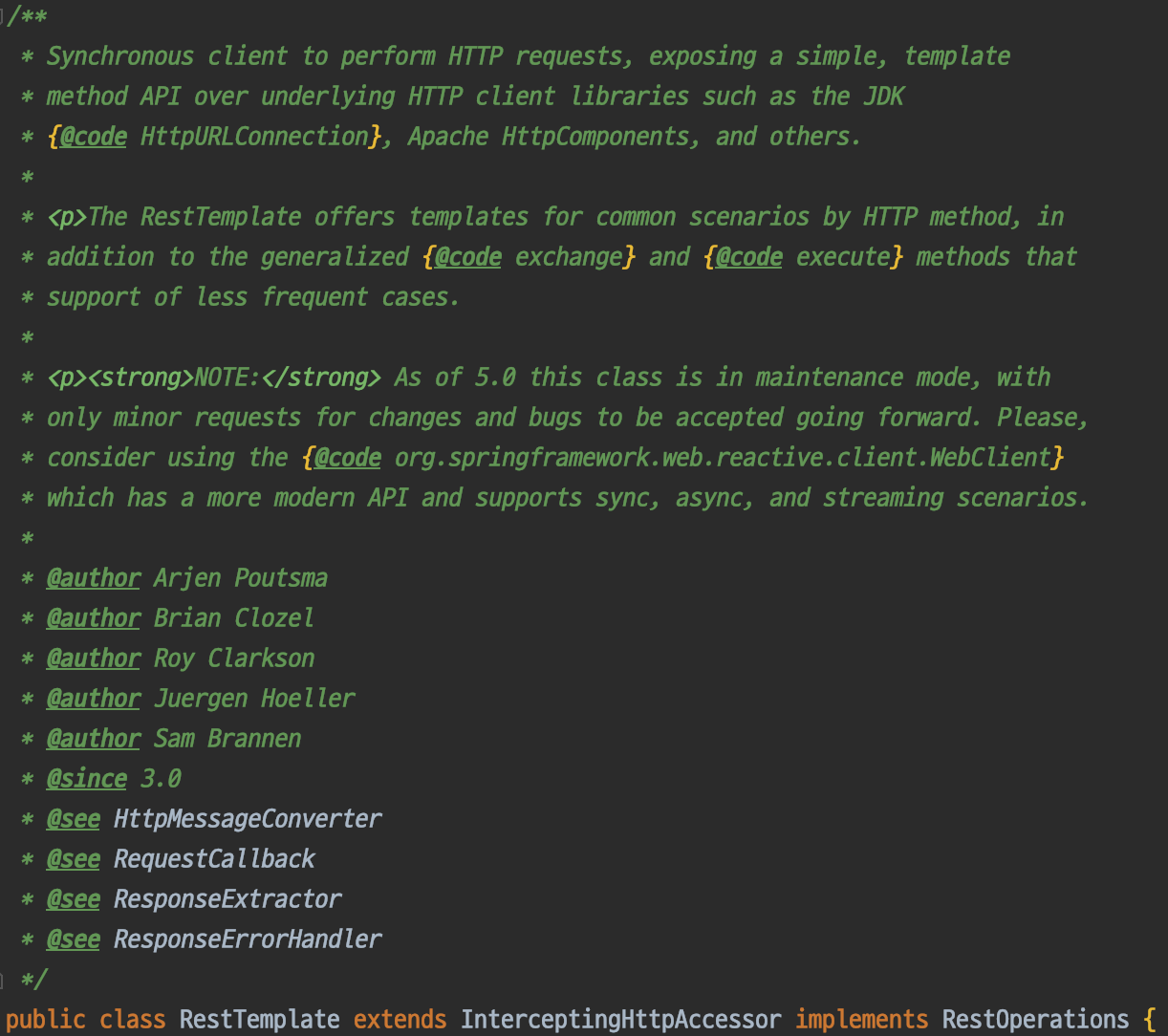Spring 5에 새로 추가된 WebClient는 HTTP 요청을 할 때 사용하는 클라이언트 라이브러리이다. 애플리케이션에서 WebClient를 사용하려면 build.gradle 파일에 spring-boot-starter-webflux 선언 하면 자동으로 추가된다.
요청을 보내기 위해서 내부적으로 HTTP 클라이언트를 사용한다. 기본값은 Reactor Netty의 HttpClient 를 사용한다. Reactor Netty 이외에도 다양한 HttpClient를 지원한다.
- non-blocking
- asynchronous
- synchronous
- streaming
RestTemplate은 Spring 3 버전부터 지금까지 자주 사용하는 HTTP 클라이언트 라이브러리이다. 그동안 잘쓰던 RestTemplate 에서 WebClient 로 변경해야 하는 이유는 RestTemplate은 새로운 기능이 더 이상 추가되지 않고 유지보수 모드로 들어가기 때문이다.
기존에 작성된 RestTemplate을 지금 당장 모두 들어내고 WebClient로 교체 할 필요는 없다. 문제 없이 잘 동작 하는 코드는 그대로 두고 비동기&논블록킹을 사용해야 하는 경우에만 WebClient를 적용하자.
Mono와 Flux는 Reactvie Stream의 Publisher 인터페이스를 구현한 클래스이다.
- Mono: 0 또는 1개의 결과만을 처리하는 Reactor 객체
- Flux: 0 또는 N개인 여러 개의 결과를 처리하는 Reactor 객체
public interface Publisher<T> {
public void subscribe(Subscriber<? super T> s);
}HttpClient httpClient = HttpClient.create()
.tcpConfiguration(tcpClient ->
tcpClient.option(ChannelOption.CONNECT_TIMEOUT_MILLIS, 10000) // connection timeout
.doOnConnected(conn -> conn
.addHandlerLast(new ReadTimeoutHandler(10)) // read timeout
.addHandlerLast(new WriteTimeoutHandler(10)))); // write timeout
WebClient webClient = WebClient.builder()
.codecs(configurer -> configurer.defaultCodecs().maxInMemorySize(2 * 1024 * 1024))
.clientConnector(new ReactorClientHttpConnector(httpClient))
.build();
retrieve 메서드를 사용 하면 ResponseBody를 Mono 또는 Flux 객체로 바꿔준다. 4xx 또는 5xx 에러를 처리 하려면 onStatus 핸들러를 사용한다.
WebClient client = WebClient.create("https://example.org");
Mono<Person> result = client.get()
.uri("/persons/{id}", id).accept(MediaType.APPLICATION_JSON)
.retrieve()
.onStatus(HttpStatus::is4xxClientError, response -> ...)
.onStatus(HttpStatus::is5xxServerError, response -> ...)
.bodyToMono(Person.class);
exchange 메서드는 retrieve 메서드처럼 HTTP 호출 결과를 가져 오는 동작은 비슷하지만 섬세한 처리를 할 수 있다는 점이 다르다.
Mono<Object> entityMono = client.get()
.uri("/persons/1")
.accept(MediaType.APPLICATION_JSON)
.exchangeToMono(response -> {
if (response.statusCode().equals(HttpStatus.OK)) {
return response.bodyToMono(Person.class);
}
else if (response.statusCode().is4xxClientError()) {
// Suppress error status code
return response.bodyToMono(ErrorContainer.class);
}
else {
// Turn to error
return response.createException().flatMap(Mono::error);
}
});
retrieve와 exchange 메서드 반환 타입은 서로 다르다.
interface RequestHeadersSpec<S extends RequestHeadersSpec<S>> {
ResponseSpec retrieve();
Mono<ClientResponse> exchange();
}ClientResponse 인터페이스 주석에는 다음과 같은 내용이 있다.
When using a ClientResponse through the WebClient exchange() method, you have to make sure that the body is consumed or released by using one of the following methods: body(BodyExtractor), bodyToMono(Class)
DefaultWebClient 클래스의 retrieve 구현을 보면 내부적으로 exechange 메서드를 호출하는 것을 볼 수 있다.
/**
* Default implementation of {@link WebClient}.
*
* @author Rossen Stoyanchev
* @author Brian Clozel
* @author Sebastien Deleuze
* @since 5.0
*/
class DefaultWebClient implements WebClient {
@Override
public ResponseSpec retrieve() {
return new DefaultResponseSpec(exchange(), this::createRequest);
}
}bodyValue, body 메서드를 사용해서 Request Body 컨텐츠를 설정할 수 있다.
Person person = new Person(1, "jayden");
Mono<Void> result = client.post()
.uri("/persons/{id}", id)
.contentType(MediaType.APPLICATION_JSON)
.bodyValue(person)
.retrieve()
.bodyToMono(Void.class);
Form Data를 생성 하는 방법은 두 가지가 있다. 첫 번째로 Body에 MultiValueMap<String, String> 값을 넣는 방법이 있으며, 두 번째는 BodyInserters.fromFormData()를 이용해서 인라인으로 선언하는 방법이 있다.
FormHttpMessageWriter 클래스가 자동으로 application/x-www-form-urlencoded을 content에 붙여준다.
MultiValueMap<String, String> formData = ... ;
Mono<Void> result = client.post()
.uri("/path", id)
.bodyValue(formData)
.retrieve()
.bodyToMono(Void.class);
or
Mono<Void> result = client.post()
.uri("/path", id)
.body(fromFormData("k1", "v1").with("k2", "v2"))
.retrieve()
.bodyToMono(Void.class);
WebClient client = WebClient.builder()
.filter((request, next) -> {
ClientRequest filtered = ClientRequest.from(request)
.header("foo", "bar")
.build();
return next.exchange(filtered);
})
.build();
WebClient client = WebClient.builder()
.filter((request, next) -> {
Optional<Object> usr = request.attribute("myAttribute");
// ...
})
.build();
client.get().uri("https://example.org/")
.attribute("myAttribute", "...")
.retrieve()
.bodyToMono(Void.class);
WebClient는 블로킹 동기 호출도 지원한다.
Person person = client.get().uri("/person/{id}", i).retrieve()
.bodyToMono(Person.class)
.block();
List<Person> persons = client.get().uri("/persons").retrieve()
.bodyToFlux(Person.class)
.collectList()
.block();
WebClient 사용 해서 통합 테스트 코드를 작성할 때, OkHttp Mock Server 와 같은 mock web server가 필요하다. 테스트 코드 예제는 WebClientIntegrationTests 를 참고하면 된다.


